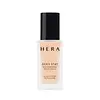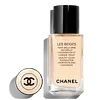What's inside
What's inside
 Key Ingredients
Key Ingredients

 Benefits
Benefits

 Concerns
Concerns

 Ingredients Side-by-side
Ingredients Side-by-side

Water
Skin ConditioningCyclopentasiloxane
EmollientCI 77891
Cosmetic ColorantTrimethylsiloxysilicate
EmollientButylene Glycol
HumectantPEG/PPG-18/18 Dimethicone
EmulsifyingCyclohexasiloxane
EmollientTitanium Dioxide
Cosmetic ColorantIsododecane
EmollientNylon-12
PEG-10 Dimethicone
Skin ConditioningCI 77492
Cosmetic ColorantPolyglyceryl-3 Diisostearate
EmulsifyingTribehenin
EmollientDisteardimonium Hectorite
StabilisingSodium Chloride
MaskingPolymethylsilsesquioxane
1,2-Hexanediol
Skin ConditioningAluminum Hydroxide
EmollientPentylene Glycol
Skin ConditioningTriethoxycaprylylsilane
CI 77491
Cosmetic ColorantAlumina
AbrasiveCaprylyl Glycol
EmollientParfum
MaskingGlyceryl Caprylate
EmollientCI 77499
Cosmetic ColorantSilica Dimethicone Silylate
AbsorbentXanthan Gum
EmulsifyingDisodium EDTA
Simethicone
EmollientPropylene Glycol
HumectantSodium Hyaluronate
HumectantEthylhexylglycerin
Skin ConditioningWater, Cyclopentasiloxane, CI 77891, Trimethylsiloxysilicate, Butylene Glycol, PEG/PPG-18/18 Dimethicone, Cyclohexasiloxane, Titanium Dioxide, Isododecane, Nylon-12, PEG-10 Dimethicone, CI 77492, Polyglyceryl-3 Diisostearate, Tribehenin, Disteardimonium Hectorite, Sodium Chloride, Polymethylsilsesquioxane, 1,2-Hexanediol, Aluminum Hydroxide, Pentylene Glycol, Triethoxycaprylylsilane, CI 77491, Alumina, Caprylyl Glycol, Parfum, Glyceryl Caprylate, CI 77499, Silica Dimethicone Silylate, Xanthan Gum, Disodium EDTA, Simethicone, Propylene Glycol, Sodium Hyaluronate, Ethylhexylglycerin
Water
Skin ConditioningDicaprylyl Carbonate
EmollientDimethicone
EmollientGlycerin
HumectantLauryl PEG-9 Polydimethylsiloxyethyl Dimethicone
Skin ConditioningSynthetic Fluorphlogopite
Isononyl Isononanoate
EmollientPentylene Glycol
Skin ConditioningPolymethylsilsesquioxane
Limnanthes Alba Seed Oil
Skin ConditioningTrimethylsiloxysilicate
EmollientKalanchoe Pinnata Leaf Extract
MaskingDimethicone/Vinyl Dimethicone Crosspolymer
Skin ConditioningStearalkonium Hectorite
Gel FormingParfum
MaskingDimethicone Crosspolymer
Emulsion StabilisingMagnesium Sulfate
Chlorphenesin
AntimicrobialCaprylyl Glycol
EmollientPropylene Carbonate
SolventAluminum Hydroxide
EmollientSodium Lauroyl Glutamate
Triethoxycaprylylsilane
Lysine
Skin ConditioningIsoceteth-10
EmulsifyingSilica
AbrasiveAlumina
AbrasiveMagnesium Chloride
Maltodextrin
AbsorbentTocopherol
AntioxidantCI 77491
Cosmetic ColorantCI 77492
Cosmetic ColorantCI 77499
Cosmetic ColorantCI 77891
Cosmetic ColorantWater, Dicaprylyl Carbonate, Dimethicone, Glycerin, Lauryl PEG-9 Polydimethylsiloxyethyl Dimethicone, Synthetic Fluorphlogopite, Isononyl Isononanoate, Pentylene Glycol, Polymethylsilsesquioxane, Limnanthes Alba Seed Oil, Trimethylsiloxysilicate, Kalanchoe Pinnata Leaf Extract, Dimethicone/Vinyl Dimethicone Crosspolymer, Stearalkonium Hectorite, Parfum, Dimethicone Crosspolymer, Magnesium Sulfate, Chlorphenesin, Caprylyl Glycol, Propylene Carbonate, Aluminum Hydroxide, Sodium Lauroyl Glutamate, Triethoxycaprylylsilane, Lysine, Isoceteth-10, Silica, Alumina, Magnesium Chloride, Maltodextrin, Tocopherol, CI 77491, CI 77492, CI 77499, CI 77891
Ingredients Explained
These ingredients are found in both products.
Ingredients higher up in an ingredient list are typically present in a larger amount.
Alumina is another name for the compound aluminum oxide. It is used as a thickener, absorbent, and abrasive.
As an absorbent, alumina can give a mattifying effect. It is used in mineral sunscreens to help coat nano-sized filters, such as titanium dioxide. By increasing the size of the UV filters, these ingredients stay on the skin for a longer time. By coating small sized ingredients, alumina helps thicken a product.
Alumina may be used as an abrasive, or exfoliant.
Alumina is naturally occurring in the mineral corundum. Certain varieties of corundum create rubies and sapphires. Corundum is also the crystalline form of alumina.
Learn more about AluminaAluminum Hydroxide is a form of aluminum. It can be naturally found in nature as the mineral gibbsite. In cosmetics, Aluminum Hydroxide is used as a colorant, pH adjuster, and absorbent.
As a colorant, Aluminum Hydroxide may add opacity, or reduce the transparency. Aluminum hydroxide is contains both basic and acidic properties.
According to manufacturers, this ingredient is an emollient and humectant. This means it helps hydrate the skin.
In medicine, this ingredient is used to help relieve heartburn and help heal ulcers.
There is currently no credible scientific evidence linking aluminum hydroxide in cosmetics to increased cancer risk.
Major health organizations allow the use of aluminum hydroxide in personal care products and have not flagged it as a carcinogenic risk at typical usage levels.
Learn more about Aluminum HydroxideCaprylyl Glycol is a humectant and emollient, meaning it attracts and preserves moisture.
It is a common ingredient in many products, especially those designed to hydrate skin. The primary benefits are retaining moisture, skin softening, and promoting a healthy skin barrier.
Though Caprylyl Glycol is an alcohol derived from fatty acids, it is not the kind that can dry out skin.
This ingredient is also used as a preservative to extend the life of products. It has slight antimicrobial properties.
Learn more about Caprylyl GlycolCi 77491 is also hydrated iron III oxide. It's sole purpose is to give a red/pink hue to products.
Iron III oxides are classified as inorganic chemicals for coloring.
Synthetically created Ci 77491 is considered safer than those naturally found. This is because the synthetically created version may contain less impurities. Iron oxides are generally non-toxic and non-allergenic.
Learn more about CI 77491Ci 77492 is also hydrated iron III oxide. It's sole purpose is to give a yellow hue to products.
Iron III oxides are classified as inorganic chemicals for coloring.
Synthetically created Ci 77492 is considered safer than those naturally found. This is because the synthetically created version may contain less impurities. Iron oxides are generally non-toxic and non-allergenic.
Learn more about CI 77492Ci 77499 is also hydrated iron III oxide. It is created from mixing red and black iron oxides. This helps give shades of darkness to a product.
Iron III oxides are classified as inorganic chemicals for coloring.
Ci 77891 is a white pigment from Titanium dioxide. It is naturally found in minerals such as rutile and ilmenite.
It's main function is to add a white color to cosmetics. It can also be mixed with other colors to create different shades.
Ci 77891 is commonly found in sunscreens due to its ability to block UV rays.
Learn more about CI 77891Parfum is a catch-all term for an ingredient or more that is used to give a scent to products.
Also called "fragrance", this ingredient can be a blend of hundreds of chemicals or plant oils. This means every product with "fragrance" or "parfum" in the ingredients list is a different mixture.
For instance, Habanolide is a proprietary trade name for a specific aroma chemical. When used as a fragrance ingredient in cosmetics, most aroma chemicals fall under the broad labeling category of “FRAGRANCE” or “PARFUM” according to EU and US regulations.
The term 'parfum' or 'fragrance' is not regulated in many countries. In many cases, it is up to the brand to define this term.
For instance, many brands choose to label themselves as "fragrance-free" because they are not using synthetic fragrances. However, their products may still contain ingredients such as essential oils that are considered a fragrance by INCI standards.
One example is Calendula flower extract. Calendula is an essential oil that still imparts a scent or 'fragrance'.
Depending on the blend, the ingredients in the mixture can cause allergies and sensitivities on the skin. Some ingredients that are known EU allergens include linalool and citronellol.
Parfum can also be used to mask or cover an unpleasant scent.
The bottom line is: not all fragrances/parfum/ingredients are created equally. If you are worried about fragrances, we recommend taking a closer look at an ingredient. And of course, we always recommend speaking with a professional.
Learn more about ParfumPentylene glycol is typically used within a product to thicken it. It also adds a smooth, soft, and moisturizing feel to the product. It is naturally found in plants such as sugar beets.
The hydrophilic trait of Pentylene Glycol makes it a humectant. As a humectant, Pentylene Glycol helps draw moisture from the air to your skin. This can help keep your skin hydrated.
This property also makes Pentylene Glycol a great texture enhancer. It can also help thicken or stabilize a product.
Pentylene Glycol also acts as a mild preservative and helps to keep a product microbe-free.
Some people may experience mild eye and skin irritation from Pentylene Glycol. We always recommend speaking with a professional about using this ingredient in your routine.
Pentylene Glycol has a low molecular weight and is part of the 1,2-glycol family.
Learn more about Pentylene GlycolPolymethylsilsesquioxane is a silicone used as a film forming agent.
When applied to the skin, this ingredient creates an invisible film on the surface. This film still allows oxygen to pass through, but prevents moisture from escaping. This can help condition and hydrate the skin. It also leaves a silky feel when applied.
Polymethylsilsesquioxane has not been shown to clog pores. It has been deemed safe to use up to 55%, but most cosmetics use much less.
If you have concerns about using this ingredient, we recommend speaking with a professional.
Learn more about PolymethylsilsesquioxaneTriethoxycaprylylsilane is a silicone used to bind and stabilize ingredients.
As an emulsifier, it helps prevent ingredients from separating. This can help elongate the shelf life of products.
Triethoxycaprylylsilane is often used to coat mineral sunscreens ingredients to help give a better feel. It also helps reduce oxidative stress in sunscreens.
Learn more about TriethoxycaprylylsilaneThis silicone is an emollient. Emollients create a thin film on the skin to prevent moisture from escaping.
It is not soluble in water and helps increase water-resistance in products.
According to a manufacturer, it can blend seamlessly with silicone oils, such as Cyclopentasiloxane.
Learn more about TrimethylsiloxysilicateWater. It's the most common cosmetic ingredient of all. You'll usually see it at the top of ingredient lists, meaning that it makes up the largest part of the product.
So why is it so popular? Water most often acts as a solvent - this means that it helps dissolve other ingredients into the formulation.
You'll also recognize water as that liquid we all need to stay alive. If you see this, drink a glass of water. Stay hydrated!
Learn more about Water